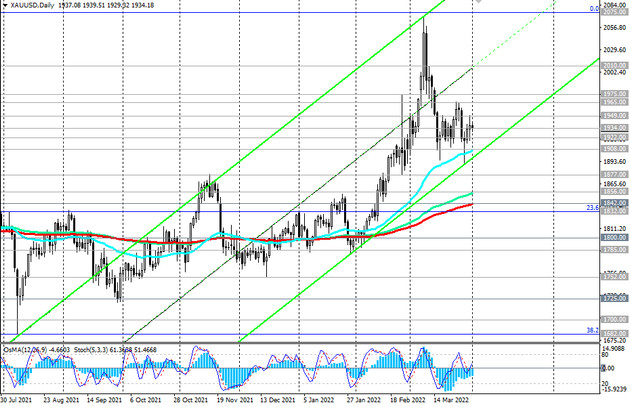Another very volatile trading week is coming to an end. Investors continue to analyze incoming macro data and follow developments in Ukraine, where Russia is conducting a special military operation. Enthusiasm of market participants, following the results of the meeting on Tuesday in Turkey between representatives of Russia and Ukraine, fell reduced, and global stock indices fell on Wednesday and Thursday. From the comments of Russian and Ukrainian government officials, it became clear that the end of the military conflict in Ukraine is still far away. The demand for the dollar as a defensive asset is growing again.
Today, the DXY dollar index is growing for the second day in a row. At the time of this writing, DXY futures are traded near 98.53, 80 points above the low reached on Tuesday, when Russian-Ukrainian negotiations ended.
World stock indices, as we noted above, also fell sharply in the previous two days, while Western countries are preparing a new package of economic sanctions against Russia. Thus, the theme of the military conflict in Ukraine remains the main driver of the financial market, while inflation continues to accelerate against the backdrop of rising energy prices.
However, the publication of important economic indicators also continues to be one of the drivers in the financial market. Today, the unconditional focus of market participants will be the publication (at 12:30 GMT) of the official monthly report of the US Department of Labor with data on employment in March. Economists expect wages to rise, jobs to rise by 490,000 and unemployment to fall another 0.1% to 3.7%. These are very strong indicators that should reinforce the market's view that the Fed is determined to tighten its monetary policy, since labor market data (along with inflation and GDP data) are key for the Fed when planning its policy.
Last week, Fed Chairman Jerome Powell confirmed the possibility of a one-time increase in interest rates by 50 basis points at once, which could happen at the next meeting on May 3-4. In total, Fed leaders are planning 6 more interest rate hikes this year. Thus, by the end of the year, the Fed interest rate should be at least 2% or more if it increases at Fed meetings not by 0.25%, but by 50%. It is also expected that the US central bank may soon begin to reduce its balance sheet, which is approximately $9 trillion.
Gold is also in demand in the current situation, although it is inferior to the dollar in this. Although gold is a popular defensive asset in a situation of rising inflation, geopolitical and economic uncertainty, its quotes are extremely sensitive to changes in the policies of the world's largest central banks, primarily the Fed. When their interest rates go up, gold quotes tend to go down.
If the US Department of Labor data published today coincides with the forecast or turns out to be better than it, then the dollar is likely to strengthen, as the likelihood of a tighter monetary policy by the Fed will increase. As for gold and the XAU/USD pair, you still need to be careful when planning your trade.
Strong data from the US labor market, of course, is a powerful positive driver for the dollar. It is logical to assume that the XAU/USD pair will decline in this case. The question is how much this decline will be, given the strong rise in inflation in the US and in the world (the annual consumer price index in the US rose by 7.9% in February (against 7.5% in January), reaching the highest level in 40 years, and in Europe, inflation was 5.8% in February, almost three times the ECB target), as well as the situation in Ukraine, a European country. In our opinion, even if the data from the US labor market is confirmed, the demand for gold will not decrease, and the fall of the XAU/USD pair will not be large-scale. But if the data does not justify market expectations, then the growth of the XAU/USD pair will resume.
Despite the Fed's plans to further tighten monetary policy, many economists expect gold prices to rise again, especially if it becomes clear that the Fed is unable to cope with rising inflation.






